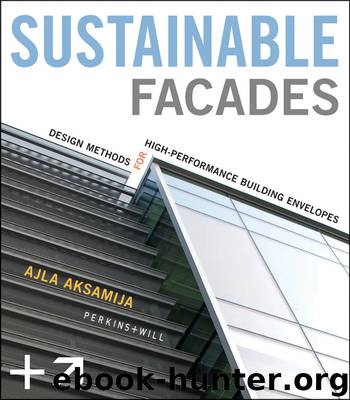Sustainable Facades by Aksamija Ajla

Author:Aksamija, Ajla
Language: eng
Format: epub
Publisher: Wiley
Published: 2013-03-05T05:00:00+00:00
First, we determine the daylight levels in the two spaces. Figure 3-23 shows simulated daylight levels on June 21 at 2:00 p.m. Because both spaces are approximately the same size, face the same direction, and have similar window configurations, it would be expected that these spaces would have similar daylighting patterns. However, an adjacent building partially blocks sunlight from reaching the facade of Laboratory 1, seen in Figure 3-22. Therefore, the daylight levels in this space are less than those in Laboratory 2, and never quite reach the recommended light levels. Laboratory 2 has much higher daylight levels near the windows, but has a significant drop-off as the distance from the windows increases; daylight falls below recommended light levels at around 9 feet (2.7 meters).
Figure 3-24 shows daylight levels for both laboratories on December 21 at 2:00 p.m. Laboratory 1 has usable daylight up to 3 feet (0.9 meter) from the windows, while Laboratory 2 has usable daylight up to around 6 feet (1.8 meters) from the windows.
What are the effects of glare? High contrasts in light levels between windows and opaque surfaces can cause glare, and Figure 3-25 shows the interior views used to calculate UGR and VCP ratings. Calculations were performed for 2:00 p.m. and 5:00 p.m. on June 21, and for 2:00 p.m. on December 21. Results are shown in Table 3-4.
Figure 3-23 Daylight levels for two spaces on June 21.
Download
This site does not store any files on its server. We only index and link to content provided by other sites. Please contact the content providers to delete copyright contents if any and email us, we'll remove relevant links or contents immediately.
The Body: A Guide for Occupants by Bill Bryson(4974)
Audition by Ryu Murakami(4850)
Adulting by Kelly Williams Brown(4487)
Housekeeping by Marilynne Robinson(4347)
Be in a Treehouse by Pete Nelson(3947)
Zero Waste Home by Bea Johnson(3777)
Seriously... I'm Kidding by Ellen DeGeneres(3577)
Better Homes and Gardens New Cookbook by Better Homes & Gardens(3525)
The Healing Self by Deepak Chopra(3474)
Barkskins by Annie Proulx(3313)
Hedgerow by John Wright(3275)
The Cellar by Natasha Preston(3260)
Spark Joy by Marie Kondo(3249)
The Genius of Japanese Carpentry by Azby Brown(3224)
The Life-Changing Magic Of Tidying Up- The Japanese Art Of Decluttering And Organizing (v5.0) by Marie Kondo(3211)
120 Days of Sodom by Marquis de Sade(3180)
Work Clean by Dan Charnas(3048)
The Book of Numbers by Peter Bentley(2912)
A Monk's Guide to a Clean House and Mind by Shoukei Matsumoto(2868)
